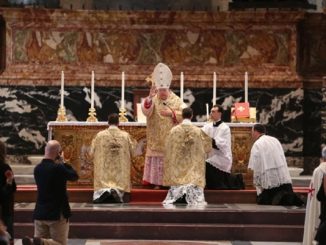
Vatican City, Jan 29, 2020 / 04:45 am (CNA).- The beatitudes should be a defining feature of a Christian’s identity because they reveal the way that Jesus lived his life, Pope Francis said Wednesday.
“The beatitudes always bring joy; they are the way to joy,” Pope Francis said Jan. 29.
“It will do us good to take the Gospel of Matthew today, chapter five verses one to eleven, and read the beatitudes — perhaps a few more times during the week — to understand this road so beautiful, so sure of the happiness that the Lord offers us,” he said in the Vatican’s Paul VI Hall.
Pope Francis said that the beatitudes should be considered “a Christian’s identity card” because they reveal “the face of Jesus himself.”
“There are eight beatitudes,” he said. “It would be nice to learn them by heart to repeat them, to have precisely in mind and heart, this law that Jesus gave us.”
Pope Francis began a new series of catechesis on the eight beatitudes from Matthew’s Gospel. In this series, the pope will reflect on one beatitude per week over the next two months in his Wednesday general audiences.
The pope said that the beatitudes are a message for all of humanity.
“It's hard not to be touched by these words of Jesus, and it is a just desire to want to understand them and to welcome them more fully,” he said.
Francis clarified that the beatitudes bring one the true joy of being “blessed,” which is different from worldly happiness.
“It is the Easter joy,” the pope said.
In giving himself to us, God often chooses “unthinkable paths” that test our limits, bringing tears or defeat, the pope said. It is the joy of one who "has the stigmata, but is alive, one who has died to himself and experienced the power of God.”
“But what does the word 'blessed' mean? The original Greek term makarios does not indicate one who has a full belly or is doing well, but is a person who is in a condition of grace, who progresses in the grace of God,” he said.
The pope noted that Jesus taught the Beatitudes as a part of his “Sermon on the Mount,” adding that the mountain is an allusion to Sinai, where God gave Moses the Ten Commandments.
“Jesus begins to teach a new law: to be poor, to be meek, to be merciful. These 'new commandments' are much more than norms. In fact, Jesus does not impose anything, but reveals the way of happiness,” Pope Francis said.
If you value the news and views Catholic World Report provides, please consider donating to support our efforts. Your contribution will help us continue to make CWR available to all readers worldwide for free, without a subscription. Thank you for your generosity!
Click here for more information on donating to CWR. Click here to sign up for our newsletter.






“Jesus begins to teach a new law: to be poor, to be meek, to be merciful.”
Jesus The Christ, fulfills The Law.
Jesus Fulfills the Law
“17Do not think that I am come to destroy the law, or the prophets. I am not come to destroy, but to fulfil. 18For amen I say unto you, till heaven and earth pass, one jot, or one tittle shall not pass of the law, till all be fulfilled. 19He therefore that shall break one of these least commandments, and shall so teach men shall be called the least in the kingdom of heaven. But he that shall do and teach, he shall be called great in the kingdom of heaven.”
Christ Has Revealed, Through His Life, His Passion, And His Death On The Cross, That No Greater Love Is There Than This, To Desire Salvation For One’s Beloved.
We are heartened to read: “that the beatitudes should be considered ‘a Christian’s identity card’ because they reveal ‘the face of Jesus himself.’ […] The pope noted that Jesus taught the Beatitudes as a part of his ‘Sermon on the Mount,’ adding that the mountain is an allusion to Sinai, where God gave Moses the Ten Commandments.”
But, then, we also read from Pope Francis: “Jesus begins to teach a new law: to be poor, to be meek, to be merciful. These ‘new commandments’ are much more than norms. In fact, Jesus does not impose anything, but reveals the way of happiness.”
Now, very hypothetically but possibly to clarify, in what instances, exactly, might the latter and “much-more-than-norms” Beatitudes possibly replace the earlier (and imposed?) commandments on Sinai? (As also proposed in one early outline, then rejected, for the new Catechism of the Catholic Church.)
In 1993, and with explicit clarity, Pope John Paul II already presented the Beatitudes as Christ’s “self-portrait…”
“These latter [the Beatitudes] are above all PROMISES, from which there also indirectly flow NORMATIVE [!] INDICATIONS for the moral life. In their originality and profundity they are a sort of SELF-PORTRAIT OF CHRIST […]” Also, “…THERE IS NO SEPARATION OR OPPOSITION between the Beatitudes and the commandments: both refer to the good, to eternal life” (Veritatis Splendor, 16, CAPS shown as italics in the original).
Should the reader now wait to see (?), if between the lines and in strategic omissions, Pope Francis’ new and co-authored book on St. John Paul II conjures Marc Antony as well as Pachamama: “Friends, Romans, countrymen, lend me your ears; I come to bury Caesar, not to praise him.”
The poor, the meek, and the merciful, will inherit the earth.